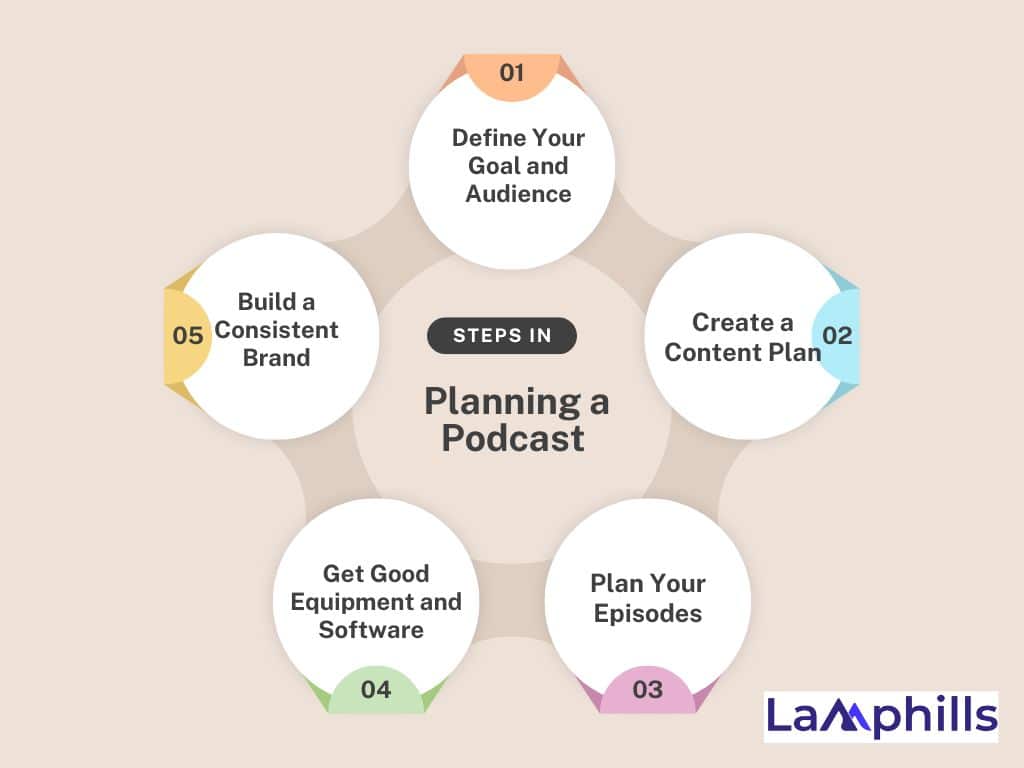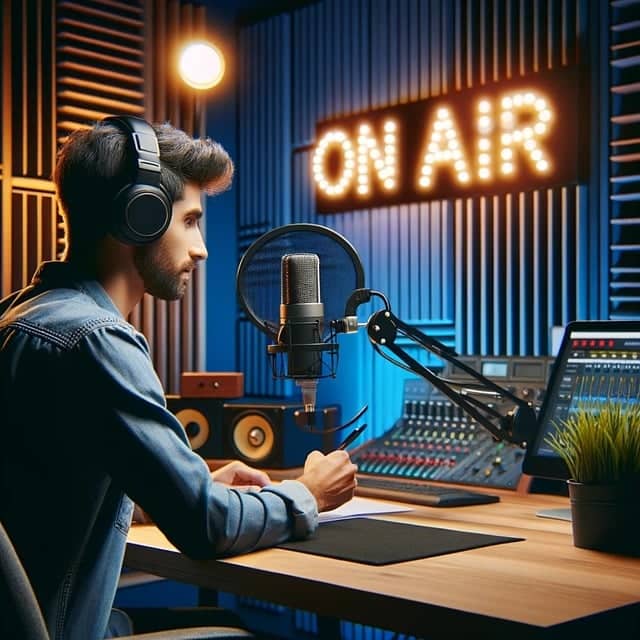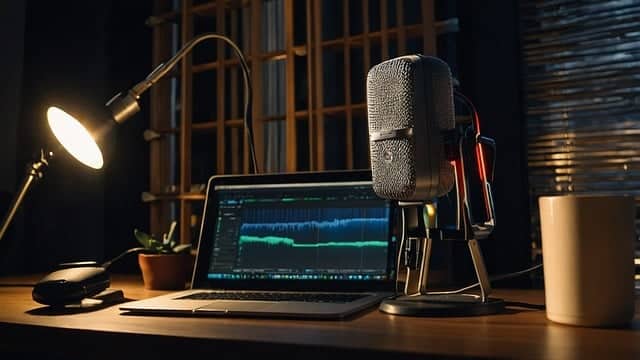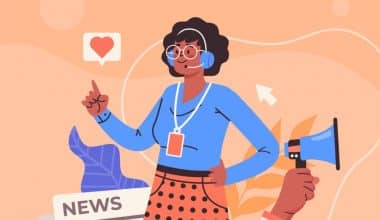If you’re not sure how to record a podcast with good quality, it can be hard to make a professional show.
Podcasts are now a very popular way to share content, making it challenging to stand out from the crowd. However, one thing that can make your podcast special is producing episodes with studio-quality sound. This involves many steps, and while experts might make it look easy, recording a studio-quality episode might feel overwhelming for beginners. But it doesn’t have to be!
The good news is that you don’t need a lot of equipment to reach that professional standard.
This simple guide will help you improve your podcast recordings. We’ll show you how to do this by explaining the audio recording process, recommending the right podcast equipment, and suggesting the best editing software. We’ll also share some expert tips you might not find in other guides.
Let’s get started.
Key Points
- Successful podcasting starts with solid planning, including defining your goals, understanding your audience, creating a content plan, and organizing your episodes.
- Investing in good podcasting equipment, such as a high-quality microphone, headphones, pop filter, windscreen, and boom arm, is vital for achieving professional sound quality.
- The space you choose for recording plays a significant role in the sound quality of your podcast.
- The choice of recording software impacts the ease and quality of your podcast production.
- Podcasting is a dynamic process where flexibility and readiness to adapt to feedback, trends, and audience preferences are key.
Before You Start Recording Your Podcast: Planning
When I first thought about starting a podcast, I felt really unsure. The idea of learning how to use audio equipment, figuring out editing software, and coming up with the right content seemed hard. I remember sitting in front of my computer, looking at an empty Audacity file, wondering if I’d ever understand how to do it. But here’s what I found out: you don’t need to be an audio expert to make a great podcast. Actually, I learned that keeping things simple often works best.

Before you start recording your new podcast, it’s important to prepare. A solid foundation is key if you want your podcast to be high-quality!
Simply put, the success of your podcast mostly depends on how well you prepare for it. Let’s look at some important steps in podcast planning that will make sure your recording goes smoothly.
#1. Define Your Goal and Audience
Every great podcast begins with a clear goal and a good understanding of who you want to reach. Start by asking yourself: What do you want to accomplish with your podcast? Who is the listener you want to connect with?
To create good content, it’s important to pick a specific topic that matches your interests and skills. Knowing your goal and audience will help you make content that fits your listeners’ needs and keeps them interested.
#2. Create a Content Plan
Creating a content plan is important to keep your podcast on track. Start by listing the topics you want to discuss, deciding on the format for your episodes, and setting the tone for your podcast.
Think about whether you’ll include guest speakers, interviews, or solo episodes (and who will be the host). Making a content calendar can help you stay organized and publish regularly, which is key to building and keeping a loyal audience.
#3. Plan Your Episodes
Before you start recording, make a clear plan for each episode. Outline the main topics you want to talk about, how you’ll organize the episode, and any materials or resources you might need.
Having a script or outline will help keep your podcast organized and ensure you share your message clearly. While it’s fine to add some spontaneity and personality, having a plan helps you avoid missing important points.
#4. Get Good Equipment and Software
We’ll talk more about this later, but it’s important to know that your podcast’s success also depends on having good sound quality. So, make sure to buy a good microphone, headphones, and audio recording/editing software. Clear, professional sound makes your podcast more enjoyable for listeners and helps build your podcast’s reputation.
#5. Build a Consistent Brand
It’s important to create a brand for your podcast that people can easily recognize. This means using the same visual style, like a logo, cover art, and social media images. Your branding should match the tone and theme of your podcast so that it’s easy to spot on different platforms.
For example, your cover art is like a billboard for your podcast. It should grab attention, show off your podcast’s personality, and make people want to listen. Whether you use fun illustrations, clean designs, or bold text, make sure it clearly represents your brand.
#6. Plan Your Podcast Episodes
While some podcasters like to record spontaneously, having a plan in place can help reduce stress. It also makes sure everything goes smoothly on recording day!
Here’s what you can do:
– Outline the general flow and structure of your episode in advance.
– Write down key points or things you need to mention.
– Think about the timing and length of your episode.
– If you have guests, prepare questions and topics to discuss before recording.
#7. Invite your Guests Early.
If you plan to have guest speakers on your podcast, make sure to invite them ahead of time. There’s nothing worse than planning an episode with a specific person in mind, only to find out they’re too busy.
Remember, the most experienced guests do not always give the best interviews; they are the ones with the most energy.
Starting a podcast can be exciting, but it’s important to plan well to ensure everything goes smoothly. This checklist will guide you through the steps you need to take before you hit record, helping you create a successful podcast from the start.
By following this checklist, you’ll be well-prepared to create a podcast that’s both enjoyable and professional. Planning ahead will make the recording process easier and help you produce content that your audience will love.
Before You Record Your Podcast: The Equipment
You might have the best topic and plan, but without the right equipment to record your podcast, it will just stay an idea. So, what do you need?
Starting a successful podcast isn’t just about having great content; good audio quality is just as important! This means you must invest in the right equipment to ensure your episodes sound clear and professional.
So, what exactly do you need to record your podcast episodes? Let’s find out.
#1. Microphone
A good microphone is a must-have if you want to create a great podcast. You should think about getting a USB or XLR microphone, depending on what you can afford and what you like. USB microphones are easy to use and plug directly into your computer, while XLR microphones give better sound quality and are better for more advanced setups. Some popular options are the Blue Yeti, Audio-Technica ATR2100x, and Shure SM7B.
#2. Headphones
A good pair of headphones is important too! Why? Because they help you listen to your audio while recording and spot any problems right away. Closed-back headphones are usually better because they keep the sound from leaking into the microphone. Brands like Sony, Audio-Technica, and Sennheiser have reliable options for podcasters.
#3. Pop Filter and Windscreen
A pop filter can make your recordings clearer by reducing strong sounds from letters like “p” and “b” and protecting your microphone from breath noises. A windscreen, on the other hand, helps cut down on wind noise and other small background sounds.
#4. Boom Arm or Microphone Stand
A boom arm or microphone stand helps you place your microphone in the right position (and it also cuts down on noise when you move the mic!). It keeps your microphone at the same distance from you and holds it steady, stopping vibrations that could mess up your audio. Brands like Rode, Blue Compass, and Heil Sound are popular choices for podcasters.
Before You Record Your Podcast: The Room
Having the right equipment is important, but where you record also matters! The space you choose can affect how your podcast sounds.
To reduce outside noises and distractions, pick a quiet room for your podcast recordings. Sounds like traffic, appliances, or other people can be distracting for your listeners and make your podcast seem less professional. So, try to find a space where you can control the background noise.
You can also reduce noise in your recording space by using thick curtains, carpets, or acoustic panels to absorb sound and minimize echoes. Turn off anything that might create noise, like air conditioners or fans, and try recording when it’s naturally quieter.
Remember, hard surfaces like walls and floors can cause echoes in your recordings. If possible, avoid recording in rooms with bare walls and floors. If your space has hard surfaces, add soft furnishings like rugs, curtains, or even pillows to help absorb sound and create a better recording environment.
Before You Record Your Podcast: The Recording Software
As you prepare to start your podcast, picking the right recording software can make a big difference. The software you choose can affect how easy it is to record and the quality of your podcast. So, let’s check out some software options for recording, editing, and even sharing your podcast!
#1. Zoom
This software is well-known for virtual meetings, but it’s also a great tool for recording podcasts, especially if you’re doing remote interviews or co-hosting with someone else.
Zoom is easy to use, and it can record separate audio tracks for each person. However, keep in mind that Zoom doesn’t save a local backup recording. So, if your internet connection drops, you could lose your content.
#2. Skype
Skype has been helping people connect worldwide for years, and it’s not just for video calls. Many podcasters love using Skype because it offers good audio quality and is easy to use. If your podcast includes guests or co-hosts who aren’t in the same place, Skype can be a good option. Make sure to have a backup recording on your end to avoid any problems if the technology acts up.
#4. Audacity
Audacity is a free audio editing software that anyone can use. It’s popular with both beginners and experienced podcasters because it’s easy to use. You can use it to record and edit your podcast episodes.
Audacity also lets you work with multiple tracks so that you can add music, sound effects, or other audio layers. It is available for Windows, macOS, and Linux.
#5. GarageBand
If you have a Mac, GarageBand is a great choice because it comes pre-installed on most Mac computers, so it’s ready to use right away. It has all the basic tools you need for recording and editing audio, and many podcasters like it because it works well with their Apple devices. Plus, GarageBand is easy to use, so whether you’re a beginner or experienced, it can get the job done.
Recording Your Podcast: Getting Your Setup Ready

Image by Michael Conway from Pixabay
Before you start recording and sharing your voice with the world, it’s important to have your podcast setup in good shape. before you read your script, let’s see how to prepare your setup!
#1. Check Your Equipment
Before you start recording, take a quick look at your gear. Make sure your microphone is working, your headphones are ready, and all the cables are connected properly. Also, check that your recording device or computer has enough storage space – you don’t want to run out of space in the middle of recording.
#2. Microphone Setup
Position your microphone so it captures clear sound. You might want to get a pop filter to reduce harsh sounds and a windscreen to cut down on background noise. If you’re using a boom arm or a microphone stand, adjust it to a comfortable height to keep the microphone at a steady distance from your mouth.
#3. Headphones On
Wearing headphones while recording is essential. They let you hear your audio as you record, so you can catch any problems right away. Use closed-back headphones to prevent sound from leaking into the microphone.
#4. Test, Test, Test
Do a quick test recording to ensure everything is working properly. Listen for background noise, audio glitches, or technical issues. This check before recording can help you avoid problems later on.
#5. Recording Environment
Check your recording space. Make sure it’s quiet and free from interruptions. You can add things like blankets or pillows to reduce echoes. If you can, record in a room with soft furniture to absorb sound and create a better environment.
#6. Lighting Matters
If you’re recording video along with your audio, pay attention to the lighting. Natural light works great, but if that’s not available, use soft, diffused lighting to avoid harsh shadows. Good lighting improves the visual quality of your content.
#7. Check Your Internet Connection
If you’re recording from a distance or live streaming, having a stable internet connection is very important. Make sure your internet speed is good enough for smooth recording or streaming. Using a wired connection can make it even more reliable.
#8. Backup Plan
Always have a backup plan. Whether it’s an extra recording device, a spare microphone, or a different place to record, being prepared for any surprises can help save your podcast episode.
Recording Your Podcast: Step-By-Step Guide
Recording a podcast can be a fun way to share your thoughts and connect with others. Whether you’re talking about a hobby, teaching something new, or just chatting with guests, making a podcast doesn’t have to be complicated.
Here’s a simple guide on how to record a podcast:
1. Plan Your Episode: Decide on your topic, outline the main points you want to discuss, and if you have guests, make sure they know the topic well.
2. Set Up Your Equipment: You’ll need a microphone, headphones, and a computer. Set these up in a quiet room to avoid background noise.
3. Use Recording Software: Install podcast recording software like Audacity (which is free) or another program you prefer. Make sure it’s set up to record.
4. Do a Sound Check: Before you start recording the main content, test your microphone and software to make sure everything sounds clear.
5. Start Recording: Hit the record button in your software and start talking! Follow your outline to keep the discussion smooth and on track.
6. Finish Recording: Once you’ve covered all your topics, stop the recording. Save your file in a format like MP3, which is commonly used for podcasts.
7. Edit Your Podcast: Use your recording software to remove mistakes or unnecessary parts, adjust the volume, or add music and effects.
8. Save and Share: Once your podcast sounds good, save the final version and share it on podcast platforms like iTunes, Spotify, or your website.
That’s all you need to start your podcast journey! By following these simple steps, you can produce and share episodes that entertain or inform your listeners.
After Recording Your Podcast: Editing and Finishing Touches
If everything went smoothly… Congratulations! You’ve recorded your podcast episode! Now, as you move into the next phase, it’s time to polish your content and make it even better with careful editing and finishing touches.
- Begin by organizing your raw audio files. Create a separate folder for each episode and label your files clearly. This first step will make the editing process easier and help you quickly find specific parts when needed.
- Before you start detailed edits, listen to the whole recording. This helps you get familiar with the content, spot any big problems, and understand the overall flow of the episode. Take note of any areas that need extra attention, like awkward pauses, background noise, or sections that might need clarification.
- Think about whether you want to cut out long pauses and filler words like “um” and “uh.” You don’t have to if you want your podcast to feel raw and real, but make sure the pacing keeps your listeners interested throughout the episode. Use this time to tighten up the content and keep the story flowing smoothly.
- Fix any audio quality issues while editing. You can use noise reduction tools to reduce background noise, adjust the volume to keep it consistent and balance the audio for a pleasant listening experience. Pay close attention to any clicks, pops, or distortions, and correct them as needed!
Adding Music and Sound Effects
A simple way to make your podcast more engaging is by adding music or sound effects at the right moments. For example, you can start your podcast with a catchy theme or use soft background music to transition between segments. Just be careful not to let the music overpower your voice—it should add to the content, not take away from it.
You don’t want your voice to get drowned out by the music. The trick is to keep the music in the background, supporting what you’re saying without taking the attention away. Think of your voice as the lead, and the music as the background support—they work together to create a great sound.
So, when choosing your music or sound effects, pick tracks that match the mood of your podcast. Keep everything in balance with your content, and you’ll create a podcast that not only sounds good but also provides a pleasant listening experience for your audience.
Adding Intro and Outro Elements
If you enjoy listening to podcasts, you’ve likely noticed that the best ones have intro and outro elements. You should think about creating a strong introduction and outro for each episode. This is your chance to set the mood, welcome your audience, and give them a preview of what’s coming. A good outro wraps up the episode nicely and leaves a lasting impression on your listeners.
If your podcast covers different segments or topics, consider adding markers or timestamps to help your audience navigate easily. This will improve the listener’s experience and make it easier for them to revisit specific parts if they want to.
Editing your podcast is an important step to ensure it sounds professional and is enjoyable for your listeners. That’s why we’ve provided a checklist to guide you through the editing process, helping you improve the quality of your episodes.
By following this checklist, you’ll create polished and engaging podcast episodes. Taking the time to edit properly will make a big difference in how your podcast is received.
Our Top Podcast Tips
We’ve discussed planning, equipment, and editing tools. Before we wrap up, let’s review a few useful tips that can really make a difference.”
#1. Embrace Your Passion
Your podcast should reflect what you care about and know well. That’s why it’s important to create a podcast you truly enjoy making.
The main idea is to follow your passion and let it show in your episodes. Whether you’re talking about specific topics, sharing personal stories, or exploring your favorite subjects, your excitement will naturally connect with your listeners.
#2. Celebrate Milestones
Make sure to celebrate the important moments in your podcast journey. Whether you’ve reached a certain number of episodes, gained more listeners, or received positive feedback, these milestones show your growth and hard work.
#3. Connect with Your Audience
It’s important to interact with your listeners and create a community around your podcast. Ask for feedback, reply to comments, and consider including listener questions or shoutouts in your episodes. Building a connection with your audience turns your podcast from a one-way message into a lively conversation.
It’s important to build a community. When you share these good moments with your listeners, you’re not celebrating alone; you’re creating a shared story of success. Your achievements become theirs, too, and they start cheering you on. So, share your milestones with your audience to create a sense of togetherness and shared success.
#4. Experiment with Content
Don’t be scared to mix things up with your podcast. You can test out different styles, bring in guest speakers, or talk about new topics. For example, one day, you might do a solo episode, and the next day, you might chat with an interesting guest. Changing things up keeps your podcast fun and exciting.
Keeping your content fresh not only keeps you interested as a podcaster but also makes each episode unique and enjoyable for your listeners.
#5. Be Flexible and Ready to Adjust
Podcasting is a journey of growth and learning. Things change, trends come and go, and your audience’s preferences can shift. So, it’s important to stay flexible and be open to adjusting your approach based on feedback and new trends.
Think of the podcasting world as an unpredictable jungle. Sometimes, you’ll need to swing from vines, climb trees, and face unexpected challenges. But that’s where the real excitement happens. Stay flexible, go with the flow, and let your podcasting journey evolve. Embrace the chance to refine your style, improve your skills, and keep up with the ever-changing podcasting world.
Conclusion
In summary, we learned in this guide:
First, there is a need for good planning. Before you start recording your podcast, it’s important to define your purpose, know your audience, create a content plan, and organize your episodes. You should also invest in quality podcasting equipment, such as a good microphone, headphones, pop filter, windscreen, and boom arms.
Setting up your podcast space matters, too. Pick a quiet, comfortable place, set up your microphone carefully, check your internet connection, and close any unnecessary apps.
Recording your podcast is more than just sharing content. Keep practising, experiment with different styles and formats, and, most importantly, have fun with it. With each episode, you’ll get better, and your podcast will grow. So grab your mic and start recording. Your podcasting adventure is just beginning!
Frequently Asked Questions
What do you need to record a podcast?
To start podcasting, you’ll just need a USB microphone, a pop filter, headphones, and a computer (or tablet). If you’re more experienced, you might also want an XLR microphone, audio interface, mixer, and microphone stand.
What’s the best app to record a podcast?
Here are the top podcast recording apps for 2024:
– GarageBand
– REAPER
– Zoom
– Logic Pro
– Squadcast
– Alitu
– Riverside. fm
– Zencastr
Can I record a podcast on my phone?
Yes, you can record a video podcast on your phone. Most modern phones have cameras that can record in HD. However, the microphones built into most phones aren’t as good as the cameras, so it’s a good idea to use an external microphone for better sound quality.
Can a podcast make money?
Yes, podcasts can make money. Since podcasts are a more personal way to connect with people, they can be an effective way to promote and sell your product or service. If you don’t have a product or service to sell, you can still make money by playing ads from sponsors. This way, you can earn income from your podcast. It’s also a good idea to grow your network.
Can podcasters make money on Spotify?
Yes, you can turn your podcasting passion into a real income. With ads, subscriptions, and more, Spotify’s monetization tools help you earn money from your audience. This is available to eligible creators in certain regions. Ads are only available for podcasts hosted with Spotify for Podcasters.
Similar Articles
The Ultimate Beginner’s Guide to Podcast Equipment: What You Need
What is Podcast Marketing: 15 Effective Strategies for Growing Your Audience
How to Create a Professional Podcast: Templates and Best Practices






